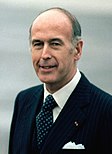French presidential election, 1974
|
|
||||||||||||||||||||||
|
||||||||||||||||||||||
|
||||||||||||||||||||||
|
|
||||||||||||||||||||||
| Results of the second round: the candidate with the plurality of votes in each administrative division. Valéry Giscard d'Estaing: blue; François Mitterrand: pink | ||||||||||||||||||||||
|
||||||||||||||||||||||
Alain Poher
(acting President after Georges Pompidou died in April)
Democratic Centre
Valéry Giscard d'Estaing
Independent Republicans
Presidential elections were held in France in 1974, following the death of President Georges Pompidou. They went to a second round, and were won by Valéry Giscard d'Estaing by a margin of 1.6%. It is to date the closest presidential election in French history.
In 1969, Georges Pompidou, formerly Prime Minister under the presidency of Charles de Gaulle, was elected President of France for a seven-year term. However, he died in office on 2 April 1974, and the French voters were called to elect his successor. The political classes were caught unawares by Pompidou's death.
On the Left, the Socialist Party (PS), the French Communist Party (PCF), and the Movement of Left Radicals (MRG) campaigned for the Common Program that they agreed in 1972. Whilst the PCF was the main force of this coalition (at least in terms of popular support), they united behind the candidacy of the PS leader François Mitterrand. Indeed, they thought the "Union of Left" could not win if it was led by a Communist in the presidential race. The fear of communism was often an argument used by the French Right to win elections. Furthermore, Mitterrand had succeeded in forcing an unexpected second ballot when he was candidate in 1965 against General De Gaulle. Only two smaller Trotskyist parties refused to support Mitterrand and the Common Program, as well as the Social Democratic Party founded by a split of Socialist elects who disapproved the alliance with the PCF. For the first time since the beginning of the Fifth Republic in 1958, the Left had a serious chance of victory.
...
Wikipedia



